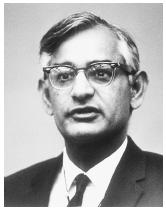Har Gobind Khorana
AMERICAN BIOCHEMIST 1922–
Har Gobind Khorana was born in a small village in British India, in which his family was among the few literate residents. He received his M.S. from the University of Lahore, and in 1945 he was awarded a grant to study for a Ph.D. at the University of Liverpool. He then went on to complete postdoctoral work in Switzerland and at Cambridge. It was there, while working with Alexander Todd, that Khorana became interested in both nucleic acids and proteins, the study of which became his life's work.
In 1952 G. M. Shrum, head of the British Research Council on the campus of the University of British Columbia, Vancouver, Canada, offered Khorana the opportunity to form his own research group on whatever topic he wished. His group became very successful in developing methods for synthesizing phosphate ester derivatives of nucleic acids, and in 1959 he and John G. Moffatt announced the synthesis of acetyl coenzyme A (acetyl CoA), a molecule essential to the biochemical processing of proteins fats and carbohydrates. Prior to this work, the coenzyme had to be extracted from yeast by a very laborious and expensive process, so this discovery led to Khorana's international recognition within the scientific community and he received many job offers as a result. He accepted the position of codirector of the Institute for Enzyme Research at the University of Wisconsin.
In the early 1960s it had been recognized that DNA and RNA (in the form of messenger RNA [mRNA]) were somehow involved in the synthesis of proteins in living cells. Whereas the basic building blocks of DNA are the four nucleotides adenosine (A), cytosine (C), guanine (G), and thymine (T)—in RNA, uracil (U) is substituted for thiamine—the basic building blocks of all proteins are twenty amino acids strung together in different sequences to produce individual proteins. In 1961, Marshall W. Nirenberg, and Heinrich J. Matthaei announced that they had created a synthetic mRNA, which, when inserted into E. coli bacteria, always caused the addition of one amino acid phenylalanine to a growing strand of linked amino acid. They also determined that if they synthesized RNA with three units of uracil joined together, it caused an amino acid chain consisting entirely of phenylalanine to be produced.
These experiments, which proved that mRNA transmits the genetic information from DNA, thus directing the creation of specific complex proteins, stimulated Khorana to use his expertise in polynucleotide synthesis to uncover the exact mechanisms involved. The results were spectacular. Within a few short years his research group was able to establish which serial combinations of nucleotides form which specific amino acids; that nucleotide instructions (genetic code ) are always transmitted to the cell in groups of three called codons; and that some of the codons direct the cell to start or stop the manufacture of proteins. For this work Khorana, along with Nirenberg and biochemist Robert W. Holley, was awarded the Nobel Prize in physiology in 1968.
In 1970 Khorana announced the creation of the first artificial DNA gene of yeast. At the same time, he and most of his research team moved to the Massachusetts Institute of Technology (MIT) because, as he explained, "You stay intellectually alive longer if you change your environment every so often" (McMurray, p. 1089). Since going to MIT, Khorana has reported major advances concerning how rhodopsin, the photo receptor in the human eye, functions.

SEE ALSO Codon ; Nucleic Acids ; Todd, Alexander .
John E. Bloor
Bibliography
McMurray, Emily J., ed. (1995). Notable Twentieth-Century Scientists. Detroit, MI: Gale Research.
Comment about this article, ask questions, or add new information about this topic: